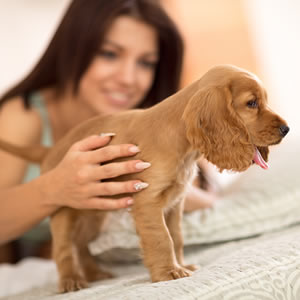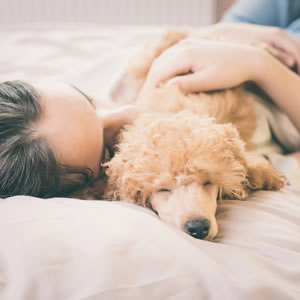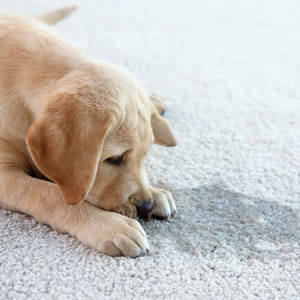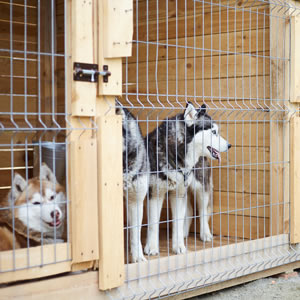
May 19th, 2020 by
Something I often see a lot of people discussing online is whether or not they should crate train their puppy. Crates are becoming increasingly popular, with many older experienced pet owners wondering where this new craze has come from. When I was getting my puppy and I told my dad I was getting her a crate he said, and I quote! “If you want to keep an animal in a cage you should have got a hamster!” Thanks, dad… He soon changed his tune when he realised if she was left out on a night she would have probably chewed through the sofa, television wires, cushions, and anything else that was left out in her reach! Here are our top do’s and don’ts of crate training a puppy, so you can decide if it is right for you or not.
 Helping your new puppy to settle in
Helping your new puppy to settle in
There are pros and cons to both crate training and not crate training. We often hear people saying “it’s cruel to keep a dog in a cage”, however, this is not the case if you’re using a crate properly. When picking up your new puppy, they will most likely have been whelped in the house, and then either kept in a ‘pen’ or moved to an outdoor kennel. To a dog, this is essentially a large crate! This is somewhere they can sleep and feel safe, something they have been used to from a very early age, so in this respect, to carry on with them in a cage when you bring them home can help them to settle easier.
Bringing your puppy home and letting them have the run of the whole house can often be overwhelming for a puppy and may worry them, causing them to have accidents. So, if you decide against using a crate, it’s useful to assign a certain area of the house for your dog where they are allowed.
 Safe and Secure
Safe and Secure
A crate-trained pooch knows that they have their own safe space that they can go to for peace and quiet, and to sleep in peace. Many dogs that are crate trained will go into their crate of their own accord to nap or relax. Crate training can be especially useful in houses where there are small children, as dogs may find it hard to find anywhere else that they can escape to when things are a bit manic!
Crates are also great places to keep your dog safe when you are unable to supervise them for short periods. If you need to nip to the shops for half an hour or take a bath, it’s good to be able to settle your pup in their crate so you don’t have to worry about them chewing on anything around the house or getting themselves into any other mischief!
Vets
If your dog ever has to stay at the vets – for whatever reason – they will most likely be in a vet’s ‘kennel’ which is basically a crate with a glass/ Perspex front. If your dog has been crate trained they are more likely to settle at the vets and feel safe, whereas a dog that has never been in a cage before could become increasingly anxious which is not ideal when they are probably already feeling worried from being at the vets in the first place!
Any injury your dog may get throughout their life may result in the vet asking you to keep them on ‘crate rest,’ which is essentially keeping them calm and still while the injury heals. This may seem impossible for a pet owner who has never crate trained their energetic spaniel, say! So not being crate trained in this instance may result in the dog doing itself more damage as they will be stressed and at risk of injuring themselves further. A dog who has been crate trained however, will more than likely be fine and settled in their crate, allowing their injury to heal nicely.
 Toilet Training
Toilet Training
Crate training can be a useful tool to help you housebreak your puppy, because dogs will not usually mess in their beds! Keeping your puppy in their crate for short periods helps them to learn how to hold their bladder, and when they exit their crate they will want to go toilet, so allowing them outside as soon as they are out of their crate will make them very keen to go, you can praise them and they will quickly learn that outside is where they go toilet!
Crating your puppy overnight will also minimise the accidents they have during the night, which can stop the bad habit of needing to go during the night from ever forming.
Car and Travel
Some dogs feel very anxious and get car sick when travelling, this is often because the motion of the car is an unusual sensation for the dog, it can be noisy and bumpy and your dog has no control over any of this! If your dog is crate trained, this can make travelling much less worrying for your four-legged friend! As they will already be accustomed to being in a crate, being in a crate in a vehicle will make them feel safe and secure.
Using a crate whilst travelling is not only safer for your dog, but also much safer for us! A loose dog in a car can be a huge distraction, potentially dangerous. Even a low-speed crash or bump could be made worse if your dog flies through the car and could even injure or kill them.
Have you ever thought about taking your beloved pooch on holiday? A new place can be worrying for your dog, and may cause them to have anxiety and not actually enjoy themselves! Your dog is more likely to settle if they are crate trained and you take the crate with you to your holiday digs, it will feel more like a home from home for them!
 Is a crate cruel?
Is a crate cruel?
A crate is a tool, that is only cruel if used incorrectly. If you lock your dog in its crate for say 12 hours a day with no human interaction, then it is your misuse of a crate that is cruel, and not the actual crate itself. Crates are useful mainly for setting your puppy up to having a good life that they behave through, with crate training actually preventing your dog from forming bad habits.
If you do choose to crate train, a crate should never be used as a punishment. It may, however, be used as a place to calm down and have a time out, but no scolding or punishment should ever be made whilst your dog is in their crate. This will make your dog feel like a crate is negative and they will not want to settle in there anymore. You can talk to your dog calmly until they settle in their crate and once calmed down, they can be allowed back out again.
A lot of people only use a crate for the first 6-12 months of their dog’s life. This is because by this time the pooch has learnt what behaviours are expected of them, what they are and are not allowed to do around the house, so the crate is no longer needed to prevent bad behaviours from happening or reinforcing good behaviours. Some people leave the crate with the door open at all times or others remove it completely. You should always allow your dog their own space that they can retreat to, however, crate or no crate!
Comments
Leave a reply
Your e-mail address will not be published. All fields are required


